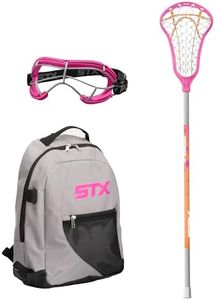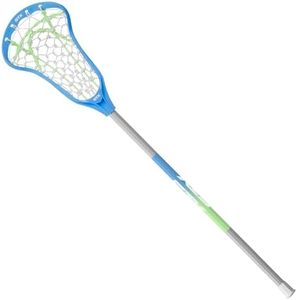We Use CookiesWe use cookies to enhance the security, performance,
functionality and for analytical and promotional activities. By continuing to browse this site you
are agreeing to our privacy policy
4 Best Womens Lacrosse Sticks
From leading brands and best sellers available on the web.Buying Guide for the Best Womens Lacrosse Sticks
Choosing the right women's lacrosse stick can greatly impact your game, comfort, and skill development no matter if you're a beginner or a seasoned player. It's important to understand the different components and features of lacrosse sticks so that you can select one that best matches your playing style, position, and experience level. Think of how you plan to use the stick, what feels comfortable in your hands, and what rules apply in your league.Stick LengthStick length refers to the overall measurement of the stick from the end of the handle to the top of the head. For women's lacrosse, rules limit the length, and it usually falls between 35.5 to 43.25 inches. Attackers and midfielders often benefit from a shorter stick for better control and quicker maneuvering, while defenders may prefer a slightly longer stick for extended reach. To pick the right one, consider your position and what feels controllable in your hands—too long may be awkward, too short may limit your defensive play.
Head Shape and PocketThe head of the stick is the part that holds the ball, and its shape and pocket depth can influence ball control, handling, and shooting. Women's lacrosse heads are generally more shallow than men's for regulation reasons. Narrower heads allow for better precision and handling, good for offensive players, while a wider head can make catching easier, which may suit beginners or defenders. The pocket, where the ball sits, should be deep enough for control but shallow enough to meet regulations. Always check your league's rules and think about whether you prioritize ball retention or fast releases.
Shaft MaterialShafts are typically made from materials like aluminum, composite, or titanium, each influencing weight, durability, and feel. Aluminum shafts are lightweight and commonly used by beginners, composites offer good strength and can have a slightly flexible feel helpful for control, and titanium is durable and strong, often favored by more advanced players. Choose a material that feels comfortable, light enough to control but strong enough to withstand checks, and suits your level of experience.
Grip and TextureThe grip or texture of the shaft provides traction and comfort in your hands, especially during rainy or intense games. Some sticks have smooth finishes while others have built-in grip or special coatings to prevent slipping. If you have sweaty hands or play in wet conditions, a textured or grippy stick may help. Test how the stick feels during play—if it slips or doesn’t feel secure, try different textures until you feel confident.
WeightStick weight affects your ability to move quickly, shoot powerfully, and handle the ball effectively. Lighter sticks help with fast passes and handling, ideal for attackers or midfielders who value speed, while slightly heavier sticks might offer more stability and are less likely to be knocked out of your hands, which can help defenders. When choosing, hold different weights and see which feels easiest to manage while still offering stability.
Stringing StyleStringing refers to how the pocket in the stick's head is woven, including mesh or traditional stringing options. Proper stringing can affect ball hold, release, and shot accuracy. Beginners may prefer factory-strung heads for consistency, while advanced players might choose customized stringing for a specific feel. Think about whether you want a stick ready to play immediately or are willing to adjust and tinker with stringing to match your preferences.





